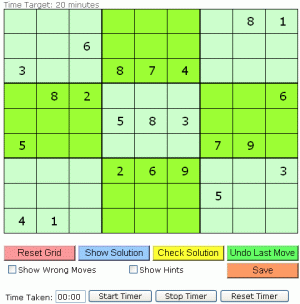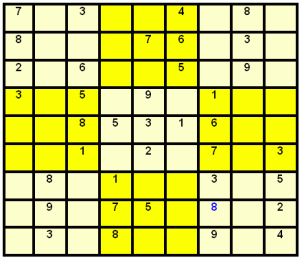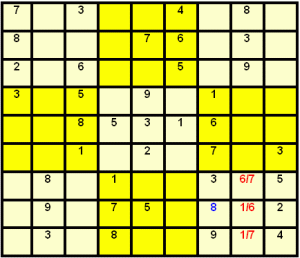Sudoku Strategy
Easy sudoku puzzles can be solved very easily, but for the harder puzzles it is good to have a few sudoku solving strategies to turn to. Here we have a look at some of those strategies:
Cross Referencing
The simplest and most frequently used method of solving sudoku is simple cross referencing. That is, for each cell there are a set number of other squares that influence what the value of that cell can be. Namely, these are the other 8 numbers in the mini square, the row and the column. By checking all those numbers, you can virtually always eliminate some possibilities for the cell you are looking at, and often work out the number with certainly. Let's have a tangible example:

Looking at the grid above, let's start in the bottom right hand 3 x 3 square. Are there any numbers we can place straight away? Well, yes there are - using our cross referencing technique.
Look at the empty cell between the '3' and the '9' in this picture. Let's try and work out its value from the numbers: 1, 2, 3, 4, 5, 6, 7, 8, 9.
First let's look in the mini square: it can't be a 2, 3, 4, 5 or 9 as there is already one. Now look in the row: it can't be a 7 either. Now the column: it also can't be a 1 or a 6. Bringing that all together, it can't be a 1, 2, 3, 4, 5, 6, 7 or 9. Which only leaves 8, so we place it thus:

Using this technique alone, you can solve many puzzles.
Pencil Marks
Another useful technique is to use pencilmarks to note the possible value of cells. For instance, in the mini square we looked at above, the only numbers left are 1, 6, 7 so these must be the values of those three cells. It is useful to record these at a glance as shown in the next image, so we remember later that as soon as we place these numbers in the adjacent squares, we can then work out with certainly which one goes where in our mini square:


